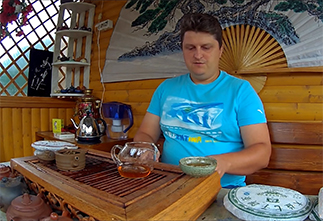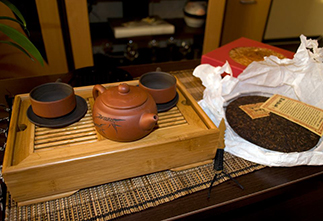Shu Puer 2016 "Jin Banzhang" brand "Kaishunhao": Depth of taste and legends of Banzhang
Shu Puer 2016 "Jin Banzhang" of the brand "Kaishunhao" is not just tea, it is a work of art created by nature and human hands. Its name, "Jin Banzhang", is translated as "Golden Banzhang", which already speaks of its value and high status among connoisseurs of puer.
The Legendary Banzhang
Banzhang is not just a village, but an entire region famous for its tea trees, some of which are hundreds of years old. Banzhang consists of five villages: Baqalun, Bakanan, Laomanye, Xinbanzhang and Laobanzhang. It is here that the tea bushes grow, which provide the raw material for the creation of the legendary puer.
- Laobanzhang is the oldest and most famous village. The tea trees here have a special aroma and taste.
- Xinbanzhang is a young village, but the tea bushes here have already won recognition for their high quality.
- Laoman'e is a village famous for its large-leaf tea bushes.
- Bacalun and Bakanan - these villages also contribute to the creation of Banzhang's unique blend.
Kaishunhao and his "Golden Banzhang"
Kaishunhao is one of the leading producers of Pu-erh. Their 2016 Golden Banzhang is the result of careful selection of raw materials, masterful processing and long aging.
- Harvesting: The leaves for this pu-erh are hand-picked during the season when the tea trees are at their peak ripeness.
- Processing: After collection, the leaves go through several stages of processing: drying, rolling, fermentation and pressing.
Taste and aroma
The 2016 Golden Banzhang has a deep, rich flavor:
- Woody and earthy notes: These are some of the most recognizable and characteristic notes of shu pu-erhs, especially those produced from ancient trees. They create a sense of depth and richness in the taste.
- Sweet notes: Sweet notes reminiscent of dried fruits, honey, caramel are present. They soften the woody tones and give the tea a more balanced taste.
- Spicy Notes: There are light spicy notes present that add zest and complexity.
- Nutty notes: They give the tea a rich and deep flavor.
Beneficial properties
- Improves digestion
- Strengthens the immune system
- Reduces cholesterol levels
- Has an antioxidant effect
How to brew
It is recommended to use a gaiwan or chahai to brew Golden Banzhang. The optimal water temperature is 95-100 degrees. The brewing time of each subsequent infusion can be increased to reveal new shades of taste.
Shu Puer 2016 "Jin Banzhang" brand "Kaishunhao" is a real treasure for puer connoisseurs. Its deep taste, rich aroma and history make it one of the most desired teas in the world.
|
Name in Chinese
|
金班章 |
|
Pinyin
|
jīn bānzhāng |
|
Translation
|
Golden Banzhang |
|
Country
|
China |
|
District
|
Xishuangbanna Dai Autonomous Prefecture |
|
Provinces
|
Yunnan (云南) |
|
Habitat
|
Булан (布朗, Bùlǎng) |
|
Manufacturer
|
Кайшуньхао (开顺号) |
|
Raw material production date
|
2016 |
|
Year of pressing
|
2016 |
|
Pressing form
|
Bing Cha (Cake Tea) |
- Комментарии
- Вконтакте
Pu-erh is one of the most unique types of tea, which only gets better with age. Many people, when they first encounter this tea, wondered: why is pu-erh more often found in pressed form (cakes, bricks, tochas), and not in loose form? The reasons for this are related to both history and the practical aspects of storing and fermenting tea. Despite modern technologies that allow the production of loose pu-erh, the shape of pressed cakes remains unchanged. And pu-erh is more often found on sale in pressed form, for example, in the form of cakes or bricks, and loose pu-erh is less common. We will talk about the reasons for pressing pu-erh into cakes in this article.
Puer is a unique Chinese tea that is distinguished by its depth of taste, complexity of aromas and versatility of aftertaste. Its taste characteristics are formed under the influence of many factors, from growing conditions to the brewing method. Let's look at the main ones.
The question often arises: how to brew puerh correctly? Sometimes the phrase "to get high" is added to it. Moreover, everyone has their own understanding of this phrase. Some mean vigor, and some - intoxication. So how to brew puerh tea correctly? Let's consider several options.
Traveling through the tea mountains, we found ourselves in another land of blue roofs - the village of Zhongcai, which is located in the Menghai district of Yunnan province. According to tradition, we were shown another local tea tree, which, according to the Chinese, is at least a million years old :) The village is very authentic, not designed for tourists, there are many wild pu-erhs there and, of course, we were warmly received. They treated us to local cuisine and tea. We also asked the residents about the prices of tea and how they have changed in recent years.
The tea ceremony occupies a special place in the centuries-old Eastern tradition. And although the essence of this phenomenon remains constant, the nature and external manifestations of the tea ceremony in different nations have their own national characteristics. In each Chinese province, the tea ceremony and the tea used in it are varied: for example, residents of the southern provinces prefer green tea, and residents of the northern provinces - red tea, in Fujian province they more often use Oolong tea, and in Yunnan province Puer tea is widely known.

























































































